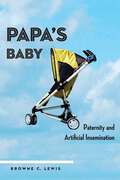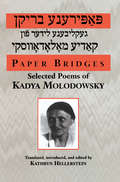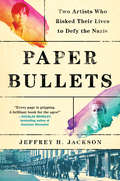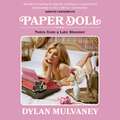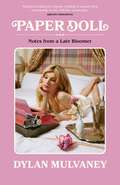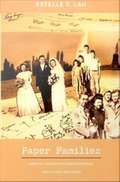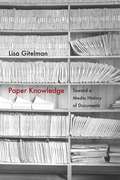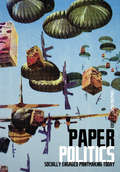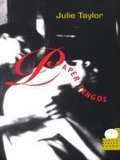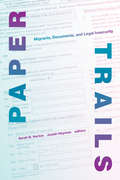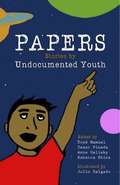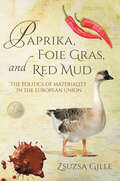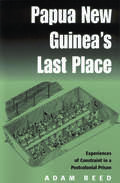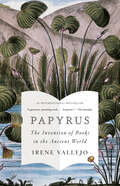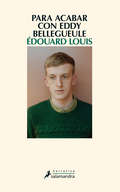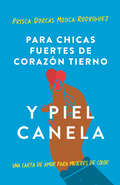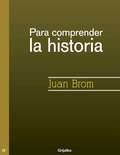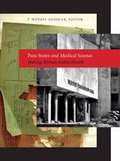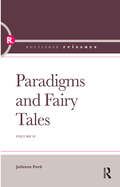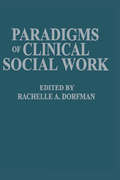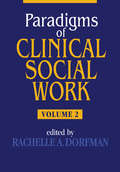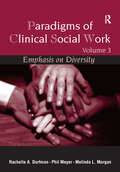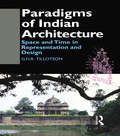- Table View
- List View
Papa's Baby: Paternity and Artificial Insemination
by Browne C. LewisWhen a child is conceived from sexual intercourse between a married, heterosexual couple, the child has a legal father and mother. Whatever may happen thereafter, the child’s parents are legally bound to provide for their child, and if they don’t, they’re held accountable by law. But what about children created by artificial insemination? When it comes to paternity, the law is full of gray areas, resulting in many cases where children have no legal fathers. In Papa’s Baby, Browne C. Lewis argues that the courts should take steps to insure that all children have at least two legal parents. Additionally, state legislatures should recognize that more than one class of fathers may exist and allocate paternal responsibility based, again, upon the best interest of the child. Lewis supplements her argument with concrete methods for dealing with different types of cases, including anonymous and non-anonymous sperm donors, married and unmarried women, and lesbian couples. In so doing, she first establishes different types of paternity, and then draws on these to create an expanded definition of paternity.
Paper Bridges: Selected Poems of Kadya Molodowsky
by Kathryn Hellerstein Kadya MolodowskyA collection of poems by an accomplished modern Yiddish poet.
Paper Bullets: Two Artists Who Risked Their Lives to Defy the Nazis
by Jeffrey H. Jackson&“A Nazi resistance story like none you&’ve ever heard or read.&” —Hampton Sides, author of Ghost Soldiers and On Desperate Ground"Every page is gripping, and the amount of new research is nothing short of mind-boggling. A brilliant book for the ages!&” —Douglas Brinkley, author of American Moonshot Longlisted for the Carnegie Medal for Excellence in NonfictionPaper Bullets is the first book to tell the history of an audacious anti-Nazi campaign undertaken by an unlikely pair: two French women, Lucy Schwob and Suzanne Malherbe, who drew on their skills as Parisian avant-garde artists to write and distribute &“paper bullets&”—wicked insults against Hitler, calls to rebel, and subversive fictional dialogues designed to demoralize Nazi troops occupying their adopted home on the British Channel Island of Jersey. Devising their own PSYOPS campaign, they slipped their notes into soldier&’s pockets or tucked them inside newsstand magazines. Hunted by the secret field police, Lucy and Suzanne were finally betrayed in 1944, when the Germans imprisoned them, and tried them in a court martial, sentencing them to death for their actions. Ultimately they survived, but even in jail, they continued to fight the Nazis by reaching out to other prisoners and spreading a message of hope. Better remembered today by their artist names, Claude Cahun and Marcel Moore, the couple&’s actions were even more courageous because of who they were: lesbian partners known for cross-dressing and creating the kind of gender-bending work that the Nazis would come to call &“degenerate art.&” In addition, Lucy was half Jewish, and they had communist affiliations in Paris, where they attended political rallies with Surrealists and socialized with artists like Gertrude Stein.Paper Bullets is a compelling World War II story that has not been told before, about the galvanizing power of art, and of resistance.
Paper Doll: Notes From A Late Bloomer
by Dylan Mulvaney'AN ESSENTIAL READ FOR ANYONE WITH A HEART' JOE LOCKE, star of Heartstopper'SHOULD BE REQUIRED READING FOR ANYONE LOOKING TO EXPAND THEIR RELATIONSHIP TO THE LGBTQ+ COMMUNITY' Kristin Chenoweth'DYLAN MAKES ME LAUGH AND MAKES ME BRAVE. I LOVE PAPER DOLL AND I LOVE THIS WOMAN' Glennon Doyle, #1 Sunday Times bestselling author of UntamedWhen Dylan Mulvaney came out as a woman online, she was a viral sensation almost overnight, emerging as a trailblazing voice on social media. Dylan's personal coming-out story blossomed into a platform for advocacy and empowerment for trans people all over the world.Through her "Days of Girlhood" series, she connected with followers by exploring what it means to be a girl, from experimenting with makeup to story times to spilling the tea about laser hair removal, while never shying away from discussing the transphobia she faced online. Nevertheless, she was determined to be a beacon of positivity.But shortly after she celebrated day 365 of being a girl, it all came screeching to a halt when an innocuous post sparked a media firestorm and right-wing backlash she couldn't have expected. Despite the vitriolic press and relentless paparazzi, Dylan was determined to remain loud and proud.In Paper Doll: Notes from a Late Bloomer, Dylan pulls back the curtain of her "It Girl" lifestyle with a witty and intimate reflection of her life pre- and post-transition. She covers everything from her first big break in theatre to the first time her dad recognized her as a girl to how she handled scandals, cancellations, and . . . tucking. It's both laugh-out-loud funny and powerfully honest-and is a love letter to everyone who stands up for queer joy.
Paper Doll: Notes From A Late Bloomer
by Dylan MulvaneyWhen Dylan Mulvaney came out as a woman online, she was a viral sensation almost overnight, emerging as a trailblazing voice on social media. Dylan's personal coming-out story blossomed into a platform for advocacy and empowerment for trans people all over the world. <p> Through her "Days of Girlhood" series, she connected with followers by exploring what it means to be a girl, from experimenting with makeup to story times to spilling the tea about laser hair removal, while never shying away from discussing the transphobia she faced online. Nevertheless, she was determined to be a beacon of positivity. But shortly after she celebrated day 365 of being a girl, it all came screeching to a halt when an innocuous post sparked a media firestorm and right-wing backlash she couldn't have expected. <p> Despite the vitriolic press and relentless paparazzi, Dylan was determined to remain loud and proud. In Paper Doll: Notes from a Late Bloomer, Dylan pulls back the curtain of her "It Girl" lifestyle with a witty and intimate reflection of her life pre- and post-transition. She covers everything from her first big break in theatre to the first time her dad recognized her as a girl to how she handled scandals, cancellations, and . . . tucking. It's both laugh-out-loud funny and powerfully honest-and is a love letter to everyone who stands up for queer joy. <b>New York Times Bestseller</b>
Paper Families: Identity, Immigration Administration, and Chinese Exclusion
by Estelle T. LauThe Chinese Exclusion Act of 1882 made the Chinese the first immigrant group officially excluded from the United States. In Paper Families, Estelle T. Lau demonstrates how exclusion affected Chinese American communities and initiated the development of restrictive U. S. immigration policies and practices. Through the enforcement of the Exclusion Act and subsequent legislation, the U. S. immigration service developed new forms of record keeping and identification practices. Meanwhile, Chinese Americans took advantage of the system's loophole: children of U. S. citizens were granted automatic eligibility for immigration. The result was an elaborate system of "paper families," in which U. S. citizens of Chinese descent claimed fictive, or "paper," children who could then use their kinship status as a basis for entry into the United States. This subterfuge necessitated the creation of "crib sheets" outlining genealogies and providing village maps and other information that could be used during immigration processing. Drawing on these documents as well as immigration case files, legislative materials, and transcripts of interviews and court proceedings, Lau reveals immigration as an interactive process. Chinese immigrants and their U. S. families were subject to regulation and surveillance, but they also manipulated and thwarted those regulations, forcing the U. S. government to adapt its practices and policies. Lau points out that the Exclusion Acts and the pseudo-familial structures that emerged in response have had lasting effects on Chinese American identity. She concludes with a look at exclusion's legacy, including the Confession Program of the 1960s that coerced people into divulging the names of paper family members and efforts made by Chinese American communities to recover their lost family histories.
Paper Knowledge: Toward a Media History of Documents
by Lisa GitelmanPaper Knowledge is a remarkable book about the mundane: the library card, the promissory note, the movie ticket, the PDF (Portable Document Format). It is a media history of the document. Drawing examples from the 1870s, the 1930s, the 1960s, and today, Lisa Gitelman thinks across the media that the document form has come to inhabit over the last 150 years, including letterpress printing, typing and carbon paper, mimeograph, microfilm, offset printing, photocopying, and scanning. Whether examining late nineteenth century commercial, or "job" printing, or the Xerox machine and the role of reproduction in our understanding of the document, Gitelman reveals a keen eye for vernacular uses of technology. She tells nuanced, anecdote-filled stories of the waning of old technologies and the emergence of new. Along the way, she discusses documentary matters such as the relation between twentieth-century technological innovation and the management of paper, and the interdependence of computer programming and documentation. Paper Knowledge is destined to set a new agenda for media studies.
Paper Politics: Socially Engaged Printmaking Today
by Josh MacPheeWith a widely eclectic variety of protest art in mediums such as relief, lithography, collagraph, and photography, this major collection of contemporary politically engaged printmaking showcases art that uses themes of social justice and global equity to engage community members in conversation. Based on an art exhibition that has traveled to more than a dozen cities in North America and including many do-it-yourself samples, this eye opening book contains works from more than 200 international artists. From the well established—Sue Coe, Swoon, Carlos Cortez—to street artists, rock poster makers, and up-and-comers such as Favianna Rodriguez and Chris Stain, this diverse collection is the work of artists who felt the need to respond to the monumental trends and events of modern politics.
Paper Tangos
by Julie TaylorTango. A multidimensional expression of Argentine identity, one that speaks to that nation's sense of disorientation, loss, and terror. Yet the tango mesmerizes dancers and audiences alike throughout the world. In Paper Tangos, Julie Taylor--a classically trained dancer and anthropologist--examines the poetics of the tango while describing her own quest to dance this most dramatic of paired dances.Taylor, born in the United States, has lived much of her adult life in Latin America. She has spent years studying the tango in Buenos Aires, dancing during and after the terror of military dictatorships. This book is at once an account of a life lived crossing the borders of two distinct and complex cultures and an exploration of the conflicting meanings of tango for women who love the poetry of its movement yet feel uneasy with the roles it bestows on the male and female dancers. Drawing parallels among the violences of the Argentine Junta, the play with power inherent in tango dancing, and her own experiences with violence both inside and outside the intriguing tango culture, Taylor weaves the line between engaging memoir and insightful cultural critique. Within the contexts of tango's creative birth and contemporary presentations, this book welcomes us directly into the tango subculture and reveals the ways that personal, political, and historical violence operate in our lives.The book's experimental design includes photographs on every page, which form a flip-book sequence of a tango. Not simply a book for tango dancers and fans, Paper Tangos will reward students of Latin American studies, cultural studies, anthropology, feminist studies, dance studies, and the art of critical memoir.
Paper Trails: Migrants, Documents, and Legal Insecurity (Global Insecurities)
by Sarah B. Horton Josiah HeymanAcross the globe, states have long aimed to control the movement of people, identify their citizens, and restrict noncitizens' rights through official identification documents. Although states are now less likely to grant permanent legal status, they are increasingly issuing new temporary and provisional legal statuses to migrants. Meanwhile, the need for migrants to apply for frequent renewals subjects them to more intensive state surveillance. The contributors to Paper Trails examine how these new developments change migrants' relationship to state, local, and foreign bureaucracies. The contributors analyze, among other toics, immigration policies in the United Kingdom, the issuing of driver's licenses in Arizona and New Mexico, the Deferred Action for Childhood Arrivals program, and community know-your-rights campaigns. By demonstrating how migrants are inscribed into official bureaucratic systems through the issuance of identification documents, the contributors open up new ways to understand how states exert their power and how migrants must navigate new systems of governance.Contributors. Bridget Anderson, Deborah A. Boehm, Susan Bibler Coutin, Ruth Gomberg-Muñoz, Sarah B. Horton, Josiah Heyman, Cecilia Menjívar, Juan Thomas Ordóñez, Doris Marie Provine, Nandita Sharma, Monica Varsanyi
Paper of Wreckage: The Rogues, Renegades, Wiseguys, Wankers, and Relentless Reporters Who Redefined American Media
by Susan Mulcahy Frank DiGiacomoA jaw-dropping and unputdownable oral history of the New York Post and the legendary tabloid&’s cultural impact from the 1970s to today as recounted by the men and women who witnessed it firsthand. By the 1970s, the country&’s oldest continuously published newspaper had fallen on hard times, just like its nearly bankrupt hometown. When the New York Post was sold to a largely unknown Australian named Rupert Murdoch in 1976, staffers hoped it would be the start of a new golden age for the paper. Now, after the nearly fifty years Murdoch has owned the tabloid, American culture reflects what Murdoch first started in the 1970s: a celebrity-focused, noisy, one-sided media empire that reached its zenith with Fox News. Drawing on extensive interviews with key players and in-depth research, this eye-opening, wildly entertaining oral history shows us how we got to this point. It&’s a rollicking tale full of bad behavior, inflated egos, and a corporate culture that rewarded skirting the rules and breaking norms. But working there was never boring and now, you can discover the entire remarkable true story of America&’s favorite tabloid newspaper.
Papers: Stories by Undocumented Youth
by José Manuel Cesar Pineda Rebecca Shine Anne Galisky Julio SalgadoThis collection includes 30 stories by undocumented youth who range in age from 10-32. They were born in countries throughout the world and raised in the United States. The writers sent these stories to Graham Street Productions during the production of the documentary film, "Papers: Stories of Undocumented Youth"
Paprika, Foie Gras, and Red Mud: The Politics of Materiality in the European Union (Framing the Global)
by Zsuzsa GilleIn this original and provocative study, Zsuzsa Gille examines three scandals that have shaken Hungary since it joined the European Union: the 2004 ban on paprika due to contamination, the 2008 boycott of Hungarian foie gras by Austrian animal rights activists, and the "red mud" spill of 2010, Hungary's worst environmental disaster. In each case, Gille analyzes how practices of production and consumption were affected by the proliferation of new standards and regulations that came with entry into the EU. She identifies a new modality of power—the materialization of politics, or achieving political goals with the seemingly apolitical tools of tinkering with technology and infrastructure—and elucidates a new approach to understanding globalization, materiality, and transnational politics.
Papua New Guinea's Last Place
by Adam ReedWhat kind of experience is incarceration? How should one define its constraints? The author, who conducted extensive fieldwork in a maximum-security jail in Papua New Guinea, seeks to address these questions through a vivid and sympathetic account of inmates' lives. Prison Studies is a growing field of interest for social scientists. As one of the first ethnographic studies of a prison outside western societies and Japan, this book contributes to a reinterpretation of the field's scope and assumptions. It challenges notions of what is punitive about imprisonment by exploring the creative as well as negative outcomes of detention, separation and loss. Instead of just coping, the prisoners in Papua New Guinea's Last Place find themselves drawing fresh critiques and new approaches to contemporary living.
Papua: Geopolitics and the Quest for Nationhood
by Bilveer SinghThe Papuan conflict has been on the international radar screen since Indonesia became an independent state in 1945. Since the surrender of the territory of Papua to Indonesia in 1962, a low-intensity military conflict has been building. Most Papuans believed that their right to self-determination was sacrificed on the altar of geopolitics. Later, when East Timor seceded peacefully from Indonesia, Papuans expected the same right. When this did not happen, the conflict intensified. In this pivotal work, Bilveer Singh examines the history of the Papuan struggle, and approaches to conflict resolution through the framework of its geopolitical implications. Asserting that the Papuans were treated unjustly by Indonesia and the international community, it is not surprising that many have come down squarely on the side of Papuan independence as a way out of the imbroglio. While to some extent the Papuan's case cannot be denied, definite political and strategic realities should not be ignored. Unfortunately for the Papuans, their territory has immense geopolitical, geostrategic, and economic significance - not only for Indonesia, but also for others such as the United States, China, Australia, and a number of European countries. Papua is wealthy, under-populated and backward in terms of human resource development. Its future as a distinct entity is in real danger as the Papuans are becoming the minority in their own homeland. Due to the asymmetry of power, the Papuans' struggle has not made a breakthrough that would force Indonesia to rethink the future of the territory in any fundamental way. In order to unravel the dynamics involving Papuan separatism, this study describes the Papuan political landscape. Singh explains what makes Papua unique, and how its makeup has affected the territory's political dynamics. He analyzes the emergence of Papua as a geopolitical trophy, calling into question the degree to which Papuan nationalism has crystallized. Finally, he questions whether Papua is emerging as a regional flashpoint, and, in view of its geopolitical importance, the various options available. "Papua: Geopolitics and the Quest for Nationhood" will be of interest to scholars of international relations, comparative politics of Indonesia and the Asia-Pacific, and policymaking.
Papyrus: The Invention of Books in the Ancient World
by Irene VallejoA "masterly" (Economist), prize-winning, internationally bestselling history of books in the ancient world"Exquisite. . . . Beautifully translated into English by Charlotte Whittle, who is able to convey both Vallejo&’s passionate narrative presence and her synthesising intelligence.&” —The GuardianLong before books were mass-produced, hand-copied scrolls made from Nile River reeds were the treasures of the ancient world. Emperors and pharaohs, determined to possess them, dispatched emissaries to the edges of the known world to bring them back. Exploring the deep and fascinating history of the written word, from the oral tradition to scrolls to codices, internationally bestselling author Irene Vallejo shows that books have always been a precious and precarious vehicle for civilization.Through fascinating stories from history, insightful readings of the classics, and poignant personal reflection, Vallejo traces the dramatic history of the book and the fight for its survival. At its heart a spirited love letter to language itself, Papyrus takes readers on a journey across the centuries to discover how a simple reed grown along the banks of the Nile would give birth to a rich and cherished culture.
Para acabar con Eddy Bellegueule
by Édouard LouisUna rebelión contra el mundo, contra su familia y contra la sociedad. «Excepcional.»Livres Hebdo Salí corriendo de repente. Sólo me dio tiempo a oír a mi madre, que decía Pero ¿qué hace ese idiota? No quería estar con ellos, me negaba a compartir con ellos ese momento. Yo estaba ya lejos, había dejado de pertenecer a su mundo, la carta lo decía. Salí al campo y estuve andando gran parte de la noche: el ambiente fresco del norte, los caminos de tierra, el olor de la colza, muy intenso en esa época del año. Dediqué toda la noche a elaborar mi nueva vida, lejos de allí. «La verdad es que la rebelión contra mis padres, contra la pobreza, contra mi clase social, su racismo, su violencia, sus atavismos, fue algo secundario. Porque, antes de que me alzara contra el mundo de mi infancia, el mundo de mi infancia se había alzado contra mí. Para mi familia y los demás, me había convertido en una fuente de vergüenza, incluso de repulsión. No tuve otra opción que la huida. Este libro es un intento de comprenderla.»Édouard Louis La crítica ha dicho...«Un lenguaje contenido y a la vez brutal, sin victimismos ni exaltaciones líricas [...]. A su escritura clásica, el autor opone la lengua de su entorno, que mezcla jerga local y sintaxis rota. Efectivamente, la violencia social se ejerce con el lenguaje.»Les Inrockuptibles «Magnífico [...]. Es el anuncio de una liberación y de un renacimiento a través de las palabras para escapar de la fatalidad del determinismo social.»Le Point «Tejer un texto uniendo dos registros lingüísticos tan opuestos es más que una proeza. El éxito literario es innegable.»Le Nouvel Observateur «Una narración asombrosa, a causa de la historia personal del autor, pero también de su talento.»Madame Figaro «Excepcional. Un cóctel de Zola y Dickens. Dura, a veces casi insoportable, pero también tragicómica, en cierta medida distante, pero en absoluto maniquea.»Livres Hebdo «Es el grito de cólera de un joven que expresa su asco frente al mito tenaz que convierte al proletariado en una bestia valiente, de buen corazón y amante de la vida.»Catherine Simon, Le Monde des Livres «La escritura de Édouard Louis, con su obstinación en hablar de la vergüenza, demuestra que su libro, que cae como un mazo sobre personas concretas, revela un escándalo universal de primera magnitud.»Jean Birnbaum, Le Monde des Livres
Para chicas fuertes de corazón tierno y piel canela: Una carta de amor para mujeres de color
by Prisca Dorcas Mojica Rodríguez“A través de su íntima manera de narrar y su cálido abrazo a las mujeres de color para quienes escribe, Mojica Rodríguez también abraza dulcemente a los lectores y los invita a transitar el duro camino a la liberación” —POPSUGAR LATINA “Provocador e iluminador. Bella y honestamente escrito, llegará al corazón de las mujeres de color que trabajan por la justicia y la equidad” —SEATTLE BOOK REVIEW Durante generaciones, las mujeres de color han tenido que luchar contra las poderosas fuerzas del sexismo, el racismo y el clasismo; una lucha bastante solitaria. Cuando Prisca Dorca Mojicas fundó Latina Rebels, creó también una comunidad que las ayuda a pelear juntas. Lo hizo de nuevo con este libro. Para chicas fuertes, de corazón tierno y piel canela ofrece sabiduría y caminos de liberación, maneras poderosas de enfrentar diversos retos y empodera a las mujeres para que desafíen la narrativa blanca y masculina contando sus propias historias. Esta es una guía hacia el orgullo y hermandad para las mujeres de piel canela y piel negra, una herramienta necesaria para avivar todo un movimiento. Tal vez prenda una chispa dentro de ti.
Para comprender la historia
by Juan BromEn el presente trabajo, cuidadosamente revisado y actualizado, Juan Brom busca "facilitar la comprensión de la Historia a quien desee una visión general y asimismo al que quiera considerar o profundizar en algún aspecto especifico". Ésta es, como todas sus obras, una invitación a reflexionar sobre nuestro pasado y sobre la importancia que éste tiene para entender mejor el mundo actual; para ello nos expone las características de la Historia como disciplina del saber, nos enseña los grandes periodos del desarrollo humano y nos da una visión de las regularidades que pueden desprenderse de su estudio. Este libro es un texto imprescindible para todos aquellos estudiosos de las Ciencias Sociales y para cualquier persona interesada en comprender mejor al ser humano y su historia. Para comprender la Historia tuvo su origen en el curso "Fundamentos de la Historia", que el autor impartió en 1962 en la universidad michoacana de San Nicolás de Hidalgo, y de 1965 a 1968 en la Universidad Autónoma de Puebla. Fue publicado en 1972 por la Editorial Nuestro Tiempo, alcanzando ahí, con varias revisiones, un tiraje total de 430.000 ejemplares hasta el año 2002, en que dejó de existir dicha editorial.
Para-States and Medical Science: Making African Global Health
by Paul Wenzel GeisslerIn Para-States and Medical Science, P. Wenzel Geissler and the contributors examine how medicine and public health in Africa have been transformed as a result of economic and political liberalization and globalization, intertwined with epidemiological and technological changes. The resulting fragmented medical science landscape is shaped and sustained by transnational flows of expertise and resources. NGOs, universities, pharmaceutical companies and other nonstate actors now play a significant role in medical research and treatment. But as the contributors to this volume argue, these groups have not supplanted the primacy of the nation-state in Africa. Although not necessarily stable or responsive, national governments remain crucial in medical care, both as employers of health care professionals and as sources of regulation, access, and - albeit sometimes counterintuitively - trust for their people. "The state" has morphed into the "para-state" -- not a monolithic and predictable source of sovereignty and governance, but a shifting, and at times ephemeral, figure. Tracing the emergence of the "global health" paradigm in Africa in the treatment of HIV, malaria, and leprosy, this book challenges familiar notions of African statehood as weak or illegitimate by elaborating complex new frameworks of governmentality that can be simultaneously functioning and dysfunctional.Contributors. Uli Beisel, Didier Fassin, P. Wenzel Geissler, Rene Gerrets, Ann Kelly, Guillaume Lachenal, John Manton, Lotte Meinert, Vinh-Kim Nguyen, Branwyn Poleykett, Susan Reynolds Whyte
Paradigms and Fairy Tales: Volume 2
by Julienne FordThis book is an introduction to the epistemology and practice of social science. It provides an exposition and critique of the ideology and practice of social science, and an examination of the professional social scientist as a manipulator of ideas and appearances.
Paradigms of Clinical Social Work
by Rachelle A. DorfmanThis fully-integrated volume written by the leading experts in the field of social work presents a wide rage of therapeutic paradigms. Especially noteworthy is the common framework provided for all paradigms discusse, thus facilitating comparison and contrast between each approach. These paradigms include cognitive, brief-oriented, and psychosocial therapies, as well as Adlerian theory and radical behavorism.
Paradigms of Clinical Social Work: Emphasis On Diversity
by Rachelle A. DorfmanThis book provokes sociological questions about the expanding number of paradigms of clinical social work and the application of clinical theory. It enhances clinical social workers' ability to make sense of people's lives so that we may help them in their struggles.
Paradigms of Clinical Social Work: Emphasis on Diversity
by Rachelle A. Dorfman-Zukerman Melinda L. Morgan Phil MeyerDesigned to mirror how social work theory and practice is taught, Paradigms of Clinical Social Work, Volume 3 presents new therapeutic models through an imaginary family experiencing common social work problems.
Paradigms of Indian Architecture: Space and Time in Representation and Design
by G. H. TillotsonThis book explores conceptions of Indian architecture and how the historical buildings of the subcontinent have been conceived and described. Investigating the design philosophies of architects and styles of analysis by architectural historians, the book explores how systems of design and ideas about aesthetics have governed both the construction of buildings in India and their subsequent interpretation.How did the political directives of the British colonial period shape the manner in which pioneer archaeologists wrote the histories of India's buildings? How might such accounts conflict with indigenous ones, or with historical aesthetics? How might paintings of buildings by British and Indian artists suggest different ways of understanding their subjects? In what ways must we revise our conceptions of space and time to understand the narrative art which adorns India's most ancient monuments? These are among the questions addressed by the contributors to the volume.
